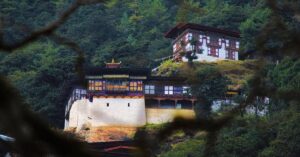Jagar Damkelsa Ney is the sacred cliff where Drubthob Nagi Rinchen meditated to rescue his mother from an ephemeral hell in Bjemina under Thimphu Dzongkhag. However, not many people know about this sacred site.
The Ney is not popular just like Khandro Ney among pilgrims, although the sacred site is near the popular Neys like Domtsang Ney and Tshelung Ney.
How to Reach Jagar Damkelsa Ney
The Ney is located southwest of Thimphu city. It’s about an hour’s drive from Thimphu towards Bjemina via the Khasadrapchu-Gidakom road. The car will take you to Damtshelkha village in Chimithang. From the Damtshelkha, it is about half an hour’s walk up to the sacred site.
You can also reach and visit this Ney while returning from a pilgrimage to Guru Rinpoche’s second Draphu Maratika. If your time permits, visit Domtsang Ney while on a pilgrimage to Jaga Damkelsa ney.
Sacred Relics to See at Jaga Damkelsa Ney
- The Sacred Cliff;
- An upturned bamboo basket on top of a wooden beam, which is 720 years old.
Also Read: Guru Rinpoche in Bhutan: His Visits to Bhutan and Sacred Sites
Historical Significance of Jagar Damkelsa Ney
According to oral history, Drubthob Naggi Rinchen came to Bhutan in search of his mother’s reincarnation. Drubthop was a Bengali Pandita and Mahasiddha born near the Chittagong district of Bangladesh.
The legend has it that the mother of the great Drubthob Nagi Rinchen was born in an ephemeral hell which was under the oven of a family in a village near the present Ney. To rescue his mother from hell, he came to work for the family here. Though the history is similar to the legend of Dho Jhaga Lam (the rock of an Indian Saint), people say that Drubthob did come to Damtshelkha village and blessed the place during the 13th century.
It’s believed that during the day, Drubthob performed whatever work was assigned to him by the family, but disappeared by night. So, the local people became curious and wanted to know where he went. One day, the people followed and found him meditating miraculously in the middle of the cliff, seated on an upturned bamboo basket on top of a wooden beam. Therefore, this sacred site was named Jagar Damkelsa Ney.
Description of Jaga Damkelsa Ney
Jagar Damkelsa Ney is the sacred place where revered Pandita Drubthob Nagi Rinchen is said to have meditated on an upturned bamboo basket on top of a wooden beam in the middle of a cliff. Because of this, the place is known as Jagar Damkelsa, meaning “the place where a crossbeam of the Siddha (Drupthob) was placed.”
To believe them, you must visit to see the miraculous signs on the cliff that no ordinary beings can ever do. You can still see an upturned bamboo basket on top of a wooden beam in the middle of the cliff.
The other sacred sites of Drubthop Naggi Rinchen are a small fortress called the Dzong Chung near the present Punakha Dzong and sacred sites in the Panikong village on the way to Tshechudrak, one of the four cliffs of Guru Rinpoche entrusted to Phajo Drugom Zhigpo.
Also Read: The 4 Sacred Cliffs of Guru Rinpoche Entrusted to Phajo Drugom Zhigpo
Best Time to Visit Jaga Damkelsa Ney
You can visit any time of the year if you’re pious, though monsoon can be quite a difficult time. As stated earlier, though Jagar Damkelsa Ney is near the road point, it is one of the least explored or visited pilgrimage sites, even for those pilgrims who regularly visit Tshelung Ney and Domtsang Ney, where all three Neys are located. You can visit major pilgrimage sites of Thimphu with the Bhutan Pilgrimage Package.
Other Sacred Sites to Explore in Thimphu
Dechenphu Lhakhang: It is a monastery dedicated to Geynyen Jagpa Melen, a powerful protective deity, located at the northern end of the Thimphu Valley in Bhutan. The Temple was constructed in the 12th century by Dampa, the son of Phajo Drugom Zhigpo.
Pangri Zampa Monastery: It is one of Bhutan’s oldest monasteries, founded in the 16th century by Ngawang Chogyal, located 8 kilometers north of Thimphu on the west bank of the Thimphu River. The monastery now functions as Bhutan’s Royal College of Astrology, where monks study traditional astrology, and the college is responsible for determining dates for important national events.
Cheri Monastery: Also known as Chagri Dorjeden Monastery, it is the first monastery established in Bhutan by Zhabdrung Ngawang Namgyel in 1620. It is located in the Upper Thimphu Valley, about 15 kilometers north of Thimphu city, perched on a hill at an altitude of approximately 2,850 meters above sea level.
Tango Monastery: The Tango Choying Dzong was founded in the 13th century by Phajo Drugom Zhigpo and rebuilt in its current form in 1688 by the Fourth Temporal Ruler, Tenzin Rabgye. The monastery is perched on a forested hillside near Cheri Mountain, famed for its spiritual legends, particularly the prophecy involving the deity Hayagriva.
Tshelung Ney: Renowned as the “Second Draphu Maratika,” it is a sacred place of prophetic longevity where Guru Rinpoche received life empowerment (Tse Ngedrup) from Tsepakme (Amitayus) during the 8th century while meditating here for four months.
Domtsang Ney: It is a sacred meditative cave where Guru Rinpoche meditated in the 8th century. Known as “Bear’s Den,” it’s a revered pilgrimage site that features holy relics like his footprint, a stone bell, and a self-emanated syllable Ah.
Enjoyed reading this blog?




